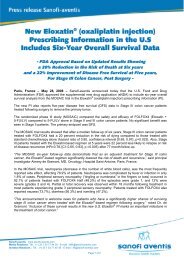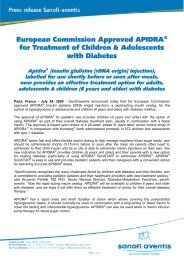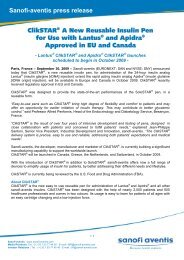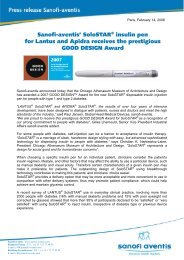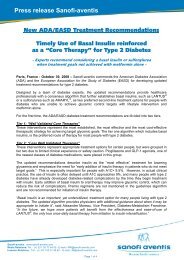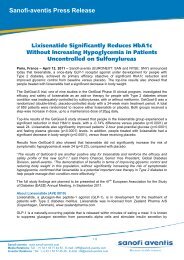Annual Report 2003 Aventis - Sanofi
Annual Report 2003 Aventis - Sanofi
Annual Report 2003 Aventis - Sanofi
You also want an ePaper? Increase the reach of your titles
YUMPU automatically turns print PDFs into web optimized ePapers that Google loves.
What is the status of the treatment and control of cardiovascular<br />
diseases today?<br />
Our approach to understanding, preventing and treating cardiovascular disease, the<br />
world’s leading cause of mortality with 8 - 10 million related deaths worldwide per<br />
year, has greatly changed over the last 50 years. While cardiovascular disease has decreased<br />
in the developed world, 80 % of cardiovascular disease today occurs in developing<br />
countries. By 2020, 85 - 90 % of cardiovascular disease cases will occur in the<br />
developing world.<br />
Lifestyle changes in different parts of the world are a fundamental driver in the<br />
prevalence of cardiovascular diseases. The industrialization of poorer countries has<br />
led to a decrease in activity, and people are eating richer food and smoking more.<br />
This has led to an increase in obesity, high blood pressure and high lipids. Meanwhile,<br />
with many people in richer nations changing towards healthier lifestyles, the<br />
risk of cardiovascular disease is decreasing.<br />
What important new developments in the fi eld will we see looking ahead?<br />
The next few decades will present some interesting challenges. Today there are a<br />
wide number of effective treatments for cardiovascular disease from ACE inhibitors<br />
and Beta blockers to simple aspirin. Going forward, we need to ask which combinations<br />
of the available therapies work best, and, most importantly, how cost effective<br />
they are. This will be the biggest challenge facing the pharmaceutical industry.<br />
We will also need to concentrate our efforts on fi nding ways to reduce the care<br />
gap to ensure that proven treatments are used widely and appropriately.<br />
How far have we come in cardiovascular risk prevention?<br />
As recently as the mid-1960s, there were no effective ways to treat cardiovascular disease.<br />
But over the last 40 years we have made tremendous progress, from controlling<br />
blood pressure to cholesterol lowering. Crucially, we are making headway towards preventing<br />
the onset of cardiovascular disease<br />
in younger segments of the population.<br />
The main challenge we face today is<br />
that most of our efforts to treat cardiovascu<br />
lar disease are based on rearguard<br />
ac tions; they do not treat the root causes<br />
of the disease: obesity, high blood pressure<br />
and high lipids. We need to focus<br />
on preventing the spread of cardiovascular<br />
disease through societal policies to<br />
promote ac tivity and a healthy diet and<br />
curb tobacco consumption and fatty<br />
foods.<br />
>> 33



